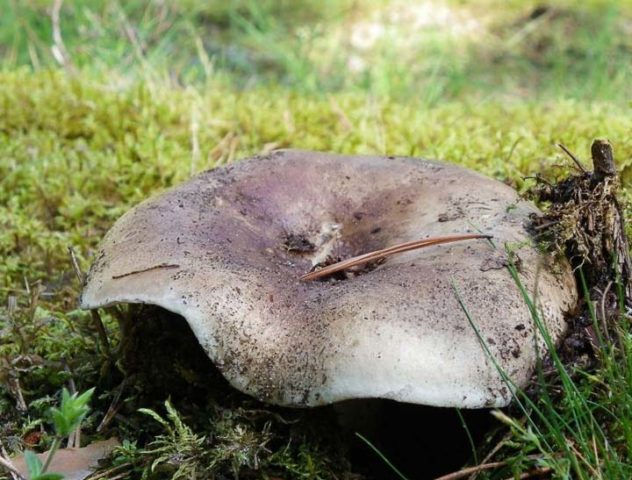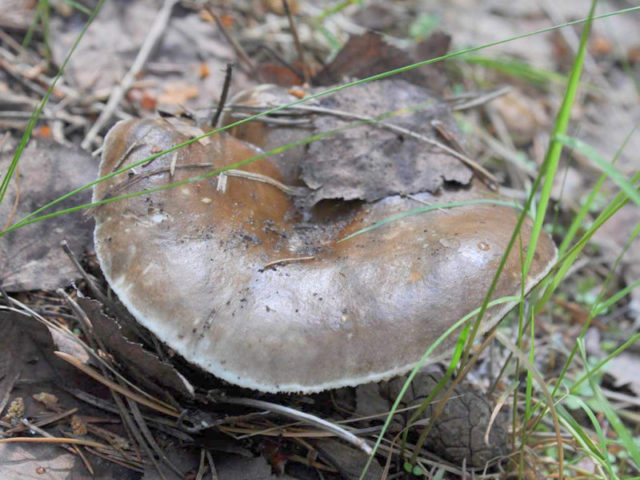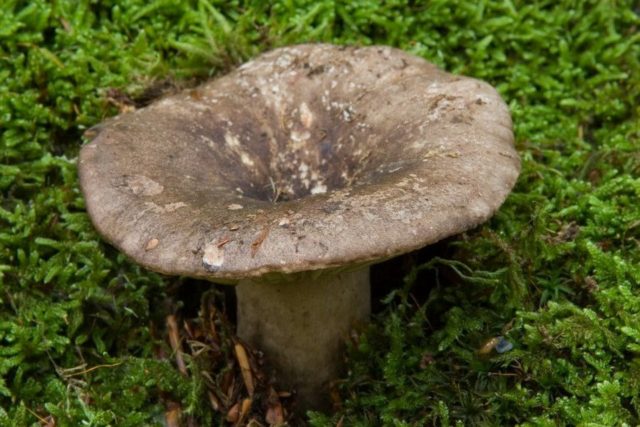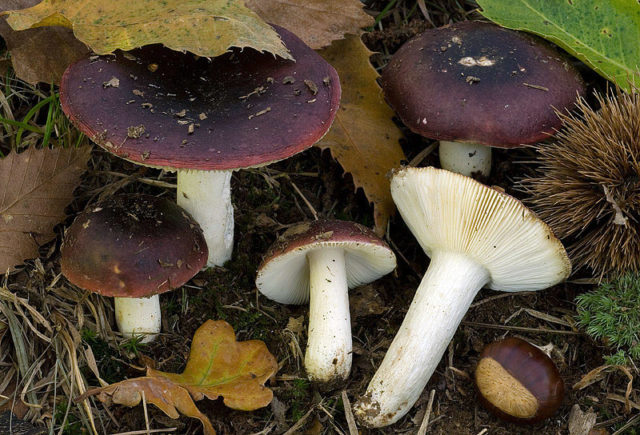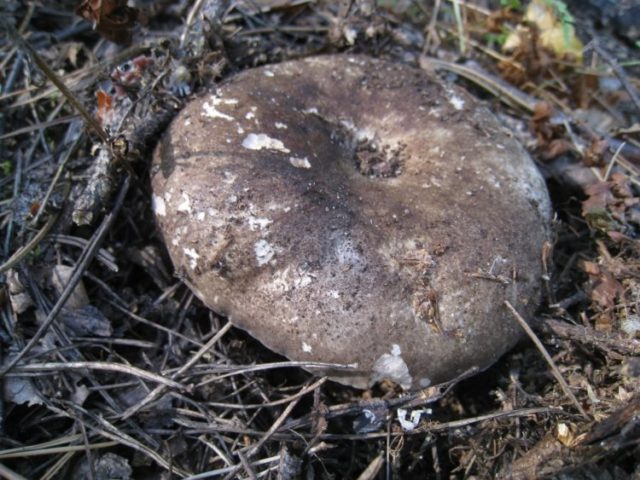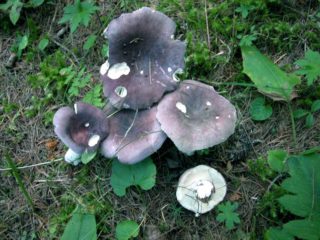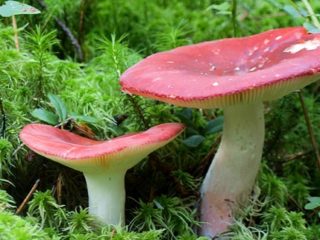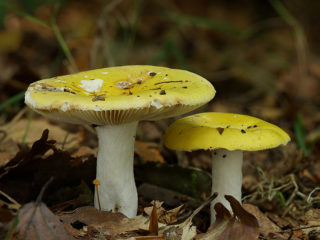Content
Black podgruzdok is a mushroom from the genus Russula, which is also called simply nigella. To properly collect and prepare the fungus, you need to learn more about what it looks like and where it is most often found.
Where black russula grow
You can meet black podgruzdok throughout Russia, although it mainly grows in the northern regions. The fungus loves well-lit places in coniferous forests with a lot of pine trees or in mixed deciduous plantings where birches grow. You can see it directly under trees or on paths, in clearings and in tall grass.
Usually the load grows in small groups. Its growth peaks in the period from July to October, but the fungus can still be considered quite rare, it is difficult to collect it in large quantities.
What does a black mushroom look like?
You can find out the load, first of all, by the cap - in young fungi it is convex, but as it grows, it straightens and becomes almost flat. According to the photo and description of the black load, the color of the cap ranges from gray-brown to dark brown-brown, and the cap is darker in the middle, and brightens almost to white at the edges.
The lower surface of the cap is covered with thin plates of a dirty gray color, if you press on these plates, they quickly turn black. In consistency, the mushroom is dense in the area of the cap, but loose in the stem. On the cut, the load has a white-gray tint, but it rapidly darkens from interaction with oxygen.
Is it possible to eat black russula
Black podgruzdok refers to conditionally edible mushrooms. However, it is not recommended to use it raw; to start loading it should be soaked and boiled, and only then salt, pickle or fry.
Taste qualities of black russula
By taste, the black podgruzdok belongs to the 4th category - this means that the taste of the mushroom is pleasant, but does not represent anything special.
Fresh mushrooms have a bitter taste, which is why it is recommended to soak them before eating them. Processed loads are mostly salted and pickled, it should be noted that the pulp of the mushrooms becomes black, and the taste is slightly sweet.
The benefits and harms of black russula
Eating extra food is good for your health, they have a rich chemical composition. They contain proteins and carbohydrates, vitamin B2 and niacin PP. At the same time, the calorie content of fungi is low, so you can eat them even with a tendency to gain excess weight.
Black russula will have a beneficial effect on gastrointestinal ailments, with too thick blood and a tendency to thrombosis.Tasty fungi have a positive effect on the state of blood vessels and the heart, and help prevent the development of many dangerous diseases.
Of course, for all its many valuable properties of loading, black can be harmful. They cannot be eaten by children under 10 years old, pregnant women and nursing mothers, the effect of fungi on the fetus and the infant's body can be unpredictable. It is better to abstain from use in the presence of acute and chronic diseases of the pancreas, with a stomach ulcer.
Mushroom picking rules
It is best to collect black podloads closer to autumn, in August and September, when they are found in maximum numbers in the forests. For harvesting, they traditionally choose areas remote from highways and industrial facilities; only mushrooms grown in ecologically clean areas will be beneficial.
Mushroom pickers need to remember that only young black russula are suitable for collection. Adult and old mushrooms, which can be recognized by their large size, are most often heavily infested with worms and have no culinary value. In addition, their flesh is tasteless and tough, and this disadvantage is not eliminated even by long-term processing.
False doubles of black russula
Photos and descriptions of the black russula indicate that it does not have poisonous counterparts, even if it is confused with other mushrooms, this will not create a health hazard. The edible counterparts include 2 fungi, also belonging to the genus Russula.
Blackening podgruzdok
The mushroom is very similar to nigella, it has the same structure and similar dimensions, it grows in mixed and deciduous forests, next to birches and pines. The main difference between the blackening load is more frequent plates on the lower surface of the cap, and the skin on the upper surface of the fungus is also darker.
The blackening variety of mushroom gives off a distinct mildew scent, which is absent in the black undergrowth. If you break the mushroom in half, then its pulp at the site of the break will immediately turn black, and not at first turn reddish, like a black russula.
Wavy russula
A black-purple, or wavy russula can also look like a black russule. Normally, the color of the cap is deep cherry, almost purple, but sometimes the color becomes similar to the color of black underload. The main difference between mushrooms is that the color of the nigella is less intense and deep than that of the wavy russula, and there is no dark spot in the middle of the cap.
Black russula recipes
Basically, black russula are used for salting for the winter, and before that they are thoroughly soaked and boiled. The recipe for cold canning of black podloads is popular; with proper salting, they can be stored for almost a year.
- Fresh loads are soaked throughout the day, periodically changing cold water. When the mushroom caps, when pressed, begin to bend, and not break, they can be removed from the water and start salting.
- Black podloads are placed in a salting container with a layer of about 5 cm, and sprinkled with salt on top and spices and spices are added - garlic, bay leaf, dill or horseradish, currant or cherry leaves, pepper.
- After that, the container must be closed, covered with a wooden flat lid and put on top of the load, and then sent to infuse for 2-3 days at room temperature.
After this time, the load is removed, the container is opened and the next layer of mushrooms, salt and spices is placed in it. The above procedure is repeated until the container is full. At the final stage, salted boiled water is added to the salted black pods, the jar is tightly corked and put away for storage.
There is also a recipe for frying black russula. Before that, they must be traditionally soaked, and ideally, boiled for at least 20 minutes in salt water.This will not only eliminate the bitter taste, but also significantly reduce the time for frying the mushrooms.
The frying process itself looks very simple:
- 250 g of onions and 3-5 cloves of garlic are finely chopped and sautéed in oil in a frying pan;
- then add 500 g of chopped black garlic to the onion and garlic and add the heat;
- stirring, fry russula until tender;
- at the last stage, add a little greens to the pan and keep the mushrooms on the fire for another 2 minutes.
Ready-made mushrooms can be dripped with 1 large spoonful of lemon juice and served.
In cooking, black pods go well with chanterelles and other varieties of russula, with oyster mushrooms and mokrukh, and other mushrooms. You can use salted and fried nigella in salads or soups, in side dishes for main courses and simply as a separate snack.
Conclusion
Black podgruzdok is a rather rare but tasty mushroom, especially well suited for pickling and pickling. With proper collection and subsequent processing, the fungus will bring unconditional benefits to the body and will delight you with a pleasant taste.
